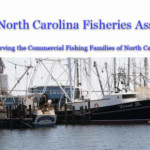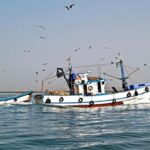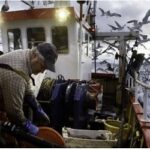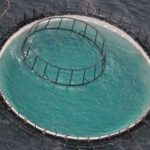Tag Archives: Snow crab
Panel Selects ASP Formula, Pulling Fair Market Share from Harvester Reach
 Minutes ago, the Standing Fish Price Setting Panel announced their decision for the 2024 snow crab season, siding with the Association of Seafood Producers formula. FFAW’s offer was based on the Blackwood report and would have seen harvesters capture a fair market value based on historic shares. ASP’s formula is not based on historic data, nor was justification found within their submission document. Moreover, there is no mechanism for harvesters to benefit as the market increases. ASP caps harvester share at 37% once the market reaches $8.02CAD, contrary to historic pricing shares that increases the harvester share as market prices increase. more, including 2024 Crab Fishery Decision, >>click to read<< 19:50
Minutes ago, the Standing Fish Price Setting Panel announced their decision for the 2024 snow crab season, siding with the Association of Seafood Producers formula. FFAW’s offer was based on the Blackwood report and would have seen harvesters capture a fair market value based on historic shares. ASP’s formula is not based on historic data, nor was justification found within their submission document. Moreover, there is no mechanism for harvesters to benefit as the market increases. ASP caps harvester share at 37% once the market reaches $8.02CAD, contrary to historic pricing shares that increases the harvester share as market prices increase. more, including 2024 Crab Fishery Decision, >>click to read<< 19:50
DFO delays opening of crab season by a week, staving off more fish harvester protests
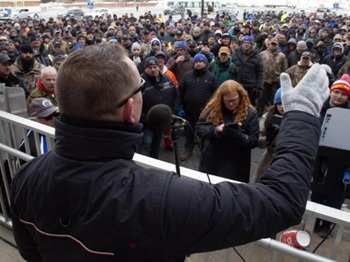 The federal government has agreed to push back the opening of the snow crab season, following a request from the fisheries union and a threat of more protests. The Department of Fisheries and Oceans made the announcement Monday evening, a day after the Fish, Food & Allied Workers union wrote to the department and asked for a one-week delay. Fish harvesters wanted time to iron out the details of an agreement last week with the provincial government to implement sweeping changes to the industry that would affect the upcoming season. DFO initially denied that request, releasing its management plan Monday morning with an expected start date of April 1, prompting influential fisherman John Efford to threaten to rally protesters outside the DFO office in St. John’s. more, >>click to read<< 17:31
The federal government has agreed to push back the opening of the snow crab season, following a request from the fisheries union and a threat of more protests. The Department of Fisheries and Oceans made the announcement Monday evening, a day after the Fish, Food & Allied Workers union wrote to the department and asked for a one-week delay. Fish harvesters wanted time to iron out the details of an agreement last week with the provincial government to implement sweeping changes to the industry that would affect the upcoming season. DFO initially denied that request, releasing its management plan Monday morning with an expected start date of April 1, prompting influential fisherman John Efford to threaten to rally protesters outside the DFO office in St. John’s. more, >>click to read<< 17:31
N.L. protest cause rooted in price-setting systems for fishers and processors
 The protest that erupted Wednesday outside the legislature in Newfoundland and Labrador has its roots in a complex, years-long struggle between independent fish harvesters and processors over the price-setting system, industry observers say. Sean Cadigan, a professor of history at Memorial University, said in an interview Thursday that one underlying factor in the tensions is the plunge in prices for snow crab, the province’s most valuable seafood export. From highs of over seven dollars per pound during the pandemic, the price fell to about two dollars per pound last year, creating hardships for harvesters at a time harvesters’ expenses are rising. He said that has combined with long-standing suspicions that harvesters have toward the small group of companies that dominate fish processing in the province. more, >>click to read<< 07:40
The protest that erupted Wednesday outside the legislature in Newfoundland and Labrador has its roots in a complex, years-long struggle between independent fish harvesters and processors over the price-setting system, industry observers say. Sean Cadigan, a professor of history at Memorial University, said in an interview Thursday that one underlying factor in the tensions is the plunge in prices for snow crab, the province’s most valuable seafood export. From highs of over seven dollars per pound during the pandemic, the price fell to about two dollars per pound last year, creating hardships for harvesters at a time harvesters’ expenses are rising. He said that has combined with long-standing suspicions that harvesters have toward the small group of companies that dominate fish processing in the province. more, >>click to read<< 07:40
Snow crab price talks have broken off, FFAW says
 Protest leader John Efford Jr. grabbed a megaphone Thursday to told the crowd that negotiations for a new crab price-setting formula had broken off ahead of the upcoming season. “There’s no agreement to be made,” he told the cheering crowd. “And how can you make an agreement when you’re trying to make an agreement with a colluded cartel that has the support of the government?” While the price-setting process has been controversial in the past, it hasn’t been at the core of the protests outside the province’s legislature this week. The Fish, Food & Allied Workers union and the Association of Seafood Processors have been working with the provincial government to establish a new formula to determine the price. more, >>click to read<< 17:12
Protest leader John Efford Jr. grabbed a megaphone Thursday to told the crowd that negotiations for a new crab price-setting formula had broken off ahead of the upcoming season. “There’s no agreement to be made,” he told the cheering crowd. “And how can you make an agreement when you’re trying to make an agreement with a colluded cartel that has the support of the government?” While the price-setting process has been controversial in the past, it hasn’t been at the core of the protests outside the province’s legislature this week. The Fish, Food & Allied Workers union and the Association of Seafood Processors have been working with the provincial government to establish a new formula to determine the price. more, >>click to read<< 17:12
Snow crab stock projected to remain healthy, for the most part, in 2024
 Fisheries and Oceans Canada released its annual stock assessment on snow crab Tuesday in St. John’s, and the data indicates the stock remains on par with last year with no major changes. That means the stock is projected to remain healthy for the majority of fishing areas around the province, with one exception. The 2HJ zone off the east coast of Labrador remains in the cautious zone, similar to last year’s assessment. But the positive news may be a result of an ocean cooling period that happened between 2012 and 2018. Snow crab flourish in colder water, allowing young crab the ability to grow to exploitable age and size. That’s between nine and 13 years old with a shell size of over 94 mm for males. Female crab cannot be retained by harvesters. more, >>click to read<< 15:06
Fisheries and Oceans Canada released its annual stock assessment on snow crab Tuesday in St. John’s, and the data indicates the stock remains on par with last year with no major changes. That means the stock is projected to remain healthy for the majority of fishing areas around the province, with one exception. The 2HJ zone off the east coast of Labrador remains in the cautious zone, similar to last year’s assessment. But the positive news may be a result of an ocean cooling period that happened between 2012 and 2018. Snow crab flourish in colder water, allowing young crab the ability to grow to exploitable age and size. That’s between nine and 13 years old with a shell size of over 94 mm for males. Female crab cannot be retained by harvesters. more, >>click to read<< 15:06
New fishery co-op partners with Dandy Dan
 Organizers of a fishery co-operative being formed to represent inshore enterprise owners have agreed to a letter of intent with Dan Meade to sell fish to the Ship Harbour-based processor. Under terms of the agreement, a new fish processing company will be formed that will see the future co-op earn an equity stake in exchange for a pledge to sell at least two million pounds of snow crab a year to the business. “The letter of intent brings the inshore fleet a step closer to breaking itself free from the company cartel,” says co-op organizer/spokesman Ryan Cleary, Executive Director of SEA-NL. Meade sees the partnership as an historic opportunity to rebuild trust with inshore harvesters. “I want to be part of that rebuilding process.” more, >>click to read<< 08:49
Organizers of a fishery co-operative being formed to represent inshore enterprise owners have agreed to a letter of intent with Dan Meade to sell fish to the Ship Harbour-based processor. Under terms of the agreement, a new fish processing company will be formed that will see the future co-op earn an equity stake in exchange for a pledge to sell at least two million pounds of snow crab a year to the business. “The letter of intent brings the inshore fleet a step closer to breaking itself free from the company cartel,” says co-op organizer/spokesman Ryan Cleary, Executive Director of SEA-NL. Meade sees the partnership as an historic opportunity to rebuild trust with inshore harvesters. “I want to be part of that rebuilding process.” more, >>click to read<< 08:49
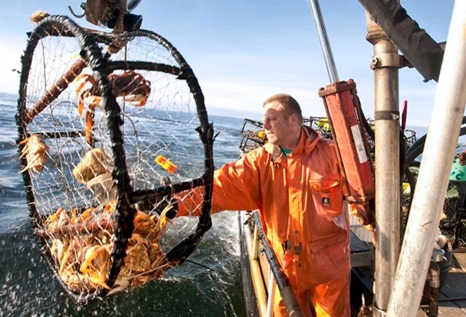
What makes Dungeness Crab Unique
Named after the town of Dungeness, Washington where people first began fishing for these crustaceans in the 1800s, Dungeness crab meat is prized by chefs and seafood connoisseurs alike for its subtle sweetness, and flaky, delicate texture. It’s easy to get lost in the moment when you’re biting into a chunk of delectable Dungeness crab meat. Still, it’s worth pausing to express gratitude toward the crab fishermen (and women) who caught that meal for you. This article covers a lot about these crabs, and you’ll know about a wide variety of crab from Dungeness to King Crab. Dungeness vs. Snow Crab, vs. Stone Crab, Photos, and more, >>click to read<< 16:50
As the once-lucrative Bering Sea crab harvest resumes, Alaska’s fishers face challenges
 In the short term, Alaska crab fishers and the communities that depend on them will get a slight reprieve from the disastrous conditions they have endured for the past two years, with harvests for iconic red king crab to open on Sunday. In the long term, the future for Bering Sea crab and the people who depend on it is clouded by environmental and economic upheaval. The decision by the Alaska Department of Fish and Game to open harvests of Bristol Bay red king crab after an unprecedented two-year shutdown was a close call, a state biologist told industry members during a meeting on Thursday. >>click to read<< 16:08
In the short term, Alaska crab fishers and the communities that depend on them will get a slight reprieve from the disastrous conditions they have endured for the past two years, with harvests for iconic red king crab to open on Sunday. In the long term, the future for Bering Sea crab and the people who depend on it is clouded by environmental and economic upheaval. The decision by the Alaska Department of Fish and Game to open harvests of Bristol Bay red king crab after an unprecedented two-year shutdown was a close call, a state biologist told industry members during a meeting on Thursday. >>click to read<< 16:08

Gear-lending program has harvesters working through closures and trying ropeless fishing gear without commitment
Snow crab fishers in one area of Nova Scotia had a new visitor this season and found themselves closed out of their fishing waters. “We got a 37 percent cut in our quota and [Northern right] whales presented themselves in our zone for the first time ever so [it was] quite stressful,” said Marc Lefort, a snow crab harvester in western Cape Breton Island and a member of Area 19 Snow Crab Fishermen’s Association in Cheticamp, N.S. He’s been fishing for 19 years in the area. “It was a challenging season.” The Northern right whale is critically endangered and conservation efforts have targeted fisheries using fixed gear, or traps connected to buoys by rope. Because whales can be entangled in the fishing gear, fisheries for lobster and snow crab have been forced to think of new measures – and new fishing gear – to protect the marine mammals. >>click to read<< 12:24

Alaska cancels snow crab harvest again due to population concerns
Crabbers from the Pacific Northwest who fish in Alaska had been watching and waiting for recommendations from the North Pacific Fishery Management Council, which met Thursday and Friday. Following the meetings, the Alaska Department of Fish and Game said Bering snow crab season will be closed for 2023-2024; Bristol Bay red king crab will open. Tanner crab will also be open for commercial fishermen. Both the snow crab and Bristol Bay red king crab seasons were closed in 2023. Crabbers and industry associations warned of the massive impact the decision would have on many small businesses, prompting calls by Congressional officials for an emergency declaration and federal aid. Video, >>click to read<< 08:18
N.L. processors dumped 5 times as much crab in 2023 as they did last year
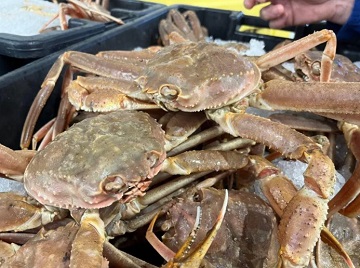 Newfoundland and Labrador fish processors dumped more than 300,000 pounds of snow crab during the past season — more than five times the amount dumped last year — according to data from the provincial Department of Fisheries, Forestry and Agriculture. In 2023, processors dumped 303,202 pounds of crab, compared with 59,239 in 2022 — a 411 per cent increase. Officials have not confirmed the reasons for the increased dumping, but harvesters blame a compressed season and unusually warmer waters. The 2023 snow crab season was marred with conflict from the outset: a six-week standoff over the $2.20-per-pound price that pushed the start of the season well into May, sending harvesters scrambling to catch what they could before cut-off and creating a bottleneck of boats on the water and product at plants. Photos, >>click to read<< 09:46
Newfoundland and Labrador fish processors dumped more than 300,000 pounds of snow crab during the past season — more than five times the amount dumped last year — according to data from the provincial Department of Fisheries, Forestry and Agriculture. In 2023, processors dumped 303,202 pounds of crab, compared with 59,239 in 2022 — a 411 per cent increase. Officials have not confirmed the reasons for the increased dumping, but harvesters blame a compressed season and unusually warmer waters. The 2023 snow crab season was marred with conflict from the outset: a six-week standoff over the $2.20-per-pound price that pushed the start of the season well into May, sending harvesters scrambling to catch what they could before cut-off and creating a bottleneck of boats on the water and product at plants. Photos, >>click to read<< 09:46
Fish plants are busy with crab, so here’s how harvesters are selling their catch of cod and are getting creative to sell it
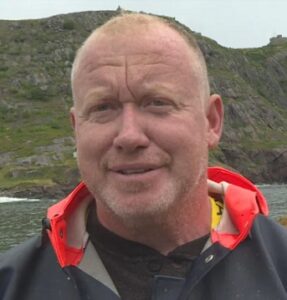 “We’re down here today filleting our fish because we have nowhere to sell our fish,” said fisherman Wade King. “None of the fish plants were buying, so we got a restaurant in Mount Pearl [buying], King Cod.” Snow crab harvesters kept their boats tied up at the beginning of the fishing season in April to protest the price set for their catch. After a six-week delay, the fishery began at the same price that had been set to start the season. But the delay means plants are still busy processing crab when they’d normally be processing cod. King said he’s still without a buyer three weeks into the cod fishery, which is something he’s never seen before. >click to read< 13:14
“We’re down here today filleting our fish because we have nowhere to sell our fish,” said fisherman Wade King. “None of the fish plants were buying, so we got a restaurant in Mount Pearl [buying], King Cod.” Snow crab harvesters kept their boats tied up at the beginning of the fishing season in April to protest the price set for their catch. After a six-week delay, the fishery began at the same price that had been set to start the season. But the delay means plants are still busy processing crab when they’d normally be processing cod. King said he’s still without a buyer three weeks into the cod fishery, which is something he’s never seen before. >click to read< 13:14
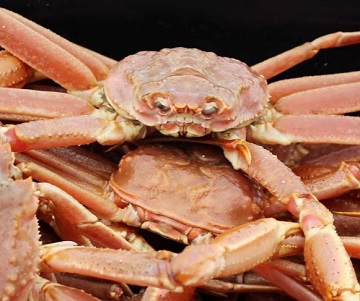
Still a lot of crab to be caught in Newfoundland and Labrador
A 2022 report by consultant David Conway, who was commissioned by the province to review the fish price setting system, recommended the industry begin discussions in October of that year to establish a formula for crab prices for the 2023 season. However, discussions between the FFAW and ASP didn’t get going until March, partly because both groups saw a change in leadership over the winter with Keith Sullivan resigning as union and Derek Butler leaving as executive director of the ASP. The decision on prices for this season fell to the province’s Fish Price Setting Panel which used the final offer selection model, where processors and the union each made a pitch on price and the panel had to choose one or the other. >click to read< 13:12
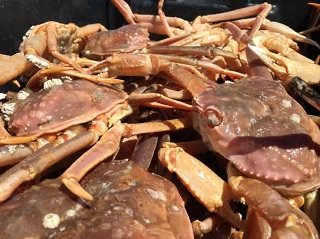
Opinion: Canada failed the N.L. fishery by Harvey Jarvis
The 2023 crash in the price of snow crab and the 1992 moratorium on northern cod have been talked about as the two major catastrophic events in the Newfoundland Labrador inshore fishery. While I totally agree that the two events have inflicted major damage on those who make a living from our ocean’s renewable resources, in my opinion, neither of them is THE major catastrophic event. In 1949, Newfoundland Labrador signed over control and management of the world’s richest renewable resources to Canada. While Canada was supposed to manage those resources to produce maximum benefit to Newfoundland Labrador, the opposite has occurred. >click to read< 13:17
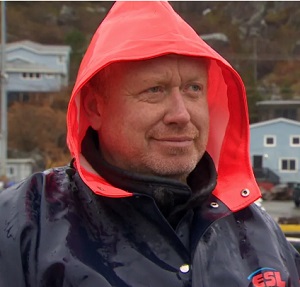
Snow crab producers, harvesters ready to move on from 6-week delay to start of season
“We have a shortened season, we have an increase in quota, and it’s very important that we keep our focus not on what has happened, but where we need to go,” ASP executive director Jeff Loder told reporters Tuesday. Loder did show slight frustration around the length of the holdout, saying both the price of $2.20 and the incremental increases were part of conversations months ago. Although the FFAW wasn’t able to change the $2.20 per pound set by the price-setting panel, President Greg Pretty says the work done in six weeks of holding out, like making sure $2.20 is the minimum price along with incremental increases, is a positive. >click to read< 15:06
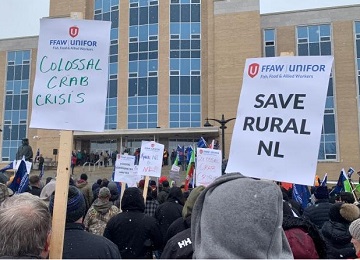
Crab fishery stalemate creating fear and uncertainty in Newfoundland fishing towns
The days of mounting fear and unease in Humber Arm South, N.L., feel like 1992, when the federal government ended the province’s cod fishery after stocks had collapsed, said Humber-Shears, the town’s mayor. “I was a teenager during that time, but it’s just that eerie kind of feeling. It’s an eerie silence,” she said. “People are really starting to fret over, ‘Where am I going to go to find work? How am I going to feed my family? How am I going to pay my mortgage?”‘ Crab fishers in Newfoundland and Labrador are refusing to fish after prices were set in early April at $2.20 a pound, a sharp drop from last year’s opening price of $7.60 a pound. The fishers say it’s not enough to make a living, and so far they haven’t budged. >click to read< 10:03
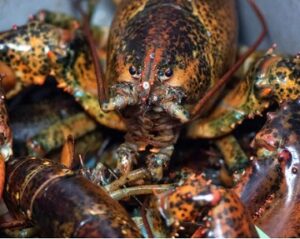
How warming waters around P.E.I. could affect snow crab and lobster
Research scientist Joël Chassé says as the atmosphere warms, the ocean waters around P.E.I. are also heating up. “Changes are happening. It’s not deniable anymore. And if the these changes don’t slow down, we will have to adapt to these changes.” Chassé said there are implications for some fish species, some positive and some negative. Fisheries and Oceans biologist Tobie Surette said that while lobster is a warm water coastal species, snow crab prefer deeper, colder waters. “Lobster has largely benefited from the warming climates, at least so far,” he said. Surette said they don’t know exactly why that is. (Snow Crab) And for now, they are doing well: “We’re at the third-highest biomass in the history of the survey right now.” But Surette knows that could change. He has been in contact with snow crab scientists from Alaska. Photos, >click to read< 18:51

P.E.I. snow crab fishers thankful for big catches as price plummets
Snow crab fishers on P.E.I. say the price they’re getting for their catch is lower than it’s been in years. Crab fishers were getting $8 a pound at the wharf last year. This year, the price has plummeted to $2.25. Fishers in some other parts of the Atlantic region are staying off the water because of the low price. Meanwhile, Island snow crab fishers have wrapped up their season. Carter Hutt, who heads the P.E.I. Snow Crab Association, said the catch was so good this year, he made his full quota in just a couple weeks. The Northport fisherman said that with the price so low and expenses so high, it was the one thing that saved him from losing money. “If you make a trip for 5,000 pounds or come in with 20,000, it basically costs you the same amount for that trip,” he said.>click to read< 19:42

Snow crab harvesters face final offer in search of better prices
The Fish, Food & Allied Workers Union and the Association of Seafood Producers have reached what the FFAW calls a final counter offer in their search for better snow crab prices. Details were shared on the union’s Facebook page at around 9:30 p.m. NT, over two hours after a meeting between the two parties began. The proposal sets $2.20 per pound as the minimum price of snow crab for the rest of the season. There is an opportunity for increases, which would be tied to the Urner Barry Index, which dictates the market price. The proposal, according to the FFAW’s Facebook page, is as follows: >click to read< 07:55
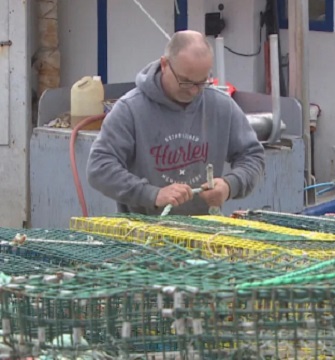
After tentative crab deal falls apart, fishermen settle in to wait for a better price
St. John’s crab fisherman Keith Boland said he and his fellow harvesters won’t accept a deal that sticks to $2.20 per pound, as decided by the provincial price-setting panel. “The $2.20 is still the major issue, and it will be, time going forward,” he said. On Friday, Fish Food & Allied Workers president Greg Pretty said a tentative deal had been reached with the Association of Seafood Producers: the $2.20 price would be locked in for the season, rather than the association requesting a lower price if the market continues to decline. But to prevent a glut of crab arriving at plants for processing, the deal would also include trip limits, with monetary penalties for fisherman who catch more than the trip limit. Calling it a union “slush fund,” Boland said fishermen won’t accept that. >click to read< 09:45
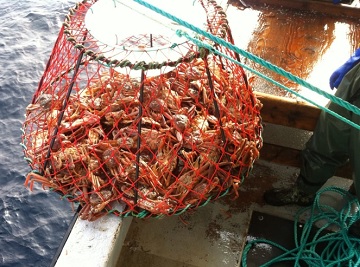
‘A Crisis of epic proportions’: FFAW rejects latest deal amidst crab fishery stalemate
The Fish Food & Allied Workers Union has rejected the most recent deal with the Association of Seafood Producers. Crab harvesters have stayed off the water since the original offer of $2.20 per pound was set by the provincial price setting panel on April 6. Since that time, the FFAW and the ASP have been stuck in a stalemate, with harvesters refusing to go out for the low price. On Saturday evening, a news release from the union stated that the tie-on would continue, after members voted to oppose the current proposal. >click to read< 11:37

NO DEAL AT 2.20, TIE ON CONTINUES
Yesterday, ASP presented a new offer to the FFAW Bargaining Committee for snow crab, offering a minimum price of 2.20 for the entirety of the 2023 season with the ability for higher reconsiderations if markets improve. The proposal included trip limits as well as an overage fund. The Committee convened yesterday afternoon to review the proposal and consulted with their respective fleets over the last day. The majority of harvesters strongly oppose the proposal, per the fleet results below. “Leadership throughout the province have been clear today: the crab is staying the water until harvesters get a higher share of the price,” says FFAW-Unifor President Greg Pretty. “FFAW-Unifor will formally reject ASP’s proposal, and the Bargaining Committee is preparing to meet for further discussions.” >click to read the Press Release< 20:05
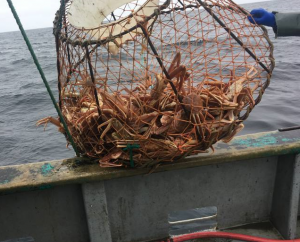
Tentative deal reached that could see snow crab harvesters back on the water
The Fish, Food & Allied Workers union has reached a tentative deal that could see snow crab harvesters back on the water in short order. The FFAW and the Association of Seafood Producers (ASP) have been stuck in a stalemate for weeks over the $2.20 per pound price set by the provincial price setting panel in early April. The industry is worth about $756 million. Many harvesters have said the $2.20 price wouldn’t make for a viable season after two years that saw prices over $7 per pound and the rising cost of fuel and other supplies. However, $2.20 per pound will still be the price for the catch but will remain in place for the entire season, not just for the three-week window offered by the ASP before it sought a price reconsideration from the price setting panel. Video, >click to read< 18:27
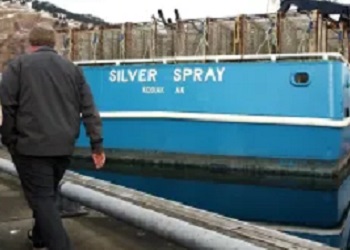
10 billion snow crabs disappeared from the Bering Sea. Scientists and fishermen are working together to understand why
The snow crabs’ population in the Bering Sea off the western coast of Alaska has fluctuated for decades. An increase in young crabs back in 2018 gave way to optimism that fishing would be good for years to come, but the hope was short-lived. Gabriel Prout and his family own the fishing vessel Silver Spray in Kodiak, Alaska. He said it was obvious something was wrong the last few years. The Bering Sea fishing grounds are usually covered in sea ice in the winter. But there wasn’t much ice, and they fished further north than usual. Finding snow crabs was still difficult. “It was just very poor fishing,” said Prout. “We searched for miles and miles and miles and really didn’t see anything.” >click to read< 10:15

SEA-NL demands province order ‘serious,’ sweeping review of fish-price setting system
Seaward Enterprises Association of Newfoundland and Labrador (SEA-NL) demands the provincial government order a “serious” and sweeping investigation into the broken fish price-setting system after last year’s token review failed to fix it. “This province’s three largest commercial fisheries — snow crab, northern shrimp, and lobster — are all in chaos this season, and two of them for the second year in a row,” says Ryan Cleary, SEA-NL’s Executive Director. “It’s obvious that last year’s lightning fast, three-month review of the price-setting system — a review that didn’t even bother to consult with inshore enterprise owners — was a token attempt at reform by a government unwilling and unprepared to act.” >click to read< 20:09

“The market has collapsed.” With crab season on the line, seafood producers’ association digs in its heels on price
Jeff Loder, executive director of the Association of Seafood Producers said Monday the crab market has softened in the past few weeks, and the group will not negotiate a new price with fishermen. “The market has collapsed. Prices need to reflect that,” he said. Loder said each day the industry is delayed, with fishermen in the Maritimes and Quebec already out on the water, the worse it is for everyone. “Snow crab is not selling. There’s a glut in inventory,” said Loder, speaking for the first time since the provincial price-setting panel set a minimum price of $2.20 Cdn per pound for harvesters, who responded with protests and say they can’t afford to fish for that price. “We need raw material to get those plants going, and to have any chance to compete with our competitors in Atlantic Canada, who are all fishing in Quebec, New Brunswick, Nova Scotia and P.E.I. at $2.25 a pound,” Video, >click to read< 16:00
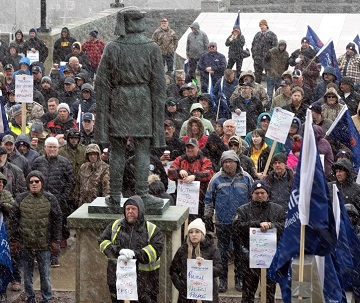
Newfoundland and Labrador crab fishery grinds to a halt as harvesters protest prices
It’s peak crab season in Newfoundland and Labrador, but hundreds of fishers spent Monday morning on land, hoisting fists and signs in the air outside the provincial legislature to protest what they say is an unlivable price for snow crab. Some in the crowd said they would much rather be out on the water than protesting. But harvesters are refusing to fish this season after prices were set at $2.20 per pound, a price they say favours fish processors over those who catch the fish. “Our money tree is the fishery of Newfoundland and Labrador, and it’s time for all Newfoundlanders and Labradorians to wake up, for that group of companies is stealing it out from under you!” yelled St. John’s fisher Glen Winslow, pounding his fist on the lectern at the top of the legislature steps. >click to read< 10:00
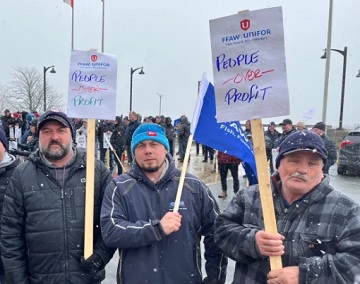
UPDATED: With their season on hold, fishermen protest low price of crab on the steps of the N.L. legislature
With the price of snow crab less than one-third of what it was a year ago, Newfoundland and Labrador’s fishermen are rallying on the steps of the provincial legislature Monday morning to demand government action on the province’s most lucrative fishery. Members of the Fish, Food & Allied Workers union say they can’t afford to fish crab at the $2.20 per pound set earlier this month. Fishing season is open, but harvesters are keeping their boats docked in the hopes of getting a higher price. >click to read< with live stream feed.


































